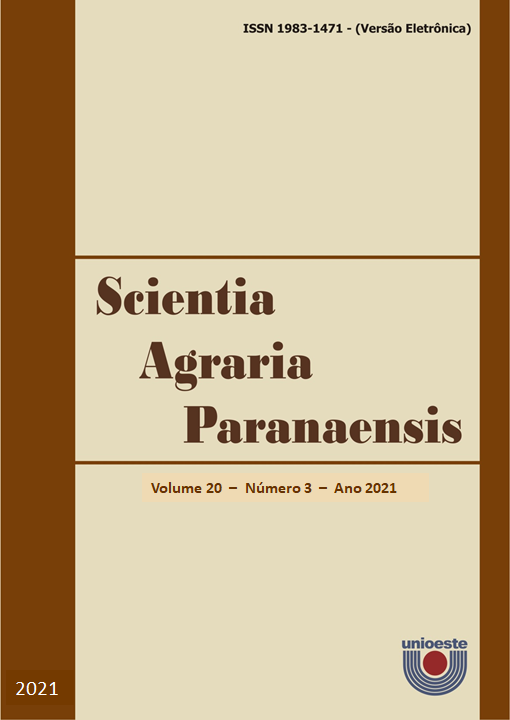Leaf pigments in cauliflower cultivated with different water conditions and silicon applications
DOI:
https://doi.org/10.18188/sap.v20i3.27740Resumo
Environmental factors and crop management can influence the characteristics of plant morphology and physiology, altering photosynthetic efficiency and mass accumulation. The study aimed to analyze the contents of leaf pigments in cauliflower cultivated under different conditions of water availability and silicon (Si) applications. The experiment was carried out in a protected environment in the city of Maringá-PR. A randomized block design, in a 3x4 factorial scheme, with three replacement conditions [40, 70 and 100% of crop evapotranspiration (ETc)] and four Si doses (0, 50, 100 and 150 kg ha-1), with four repetitions. The cauliflower cultivation, cultivar Sharon, was carried out in dystroferric RED NITOSOL. Daily evapotranspiration was determined with a constant level water table lysimeter and water replacement was performed with drip irrigation. Si was applied in split doses in three applications (initial, intermediate and final phases). At flowering, leaf tissue from the upper third of the plant was collected, with pigment extraction performed with pure acetone and determination in a spectrophotometer. At harvest, the leaf area of the plants was determined. Data were subjected to analysis of variance and regression analysis. Cauliflower crop under water-deficient reduces leaf area development and alters chloroplast pigments dynamics. Silicon use in the soil increases leaf development, chlorophyll a and b contents, and reduces carotenoids concentration. Under water stress conditions, silicon addition to the soil improves cauliflower performance.
Downloads
Publicado
Como Citar
Edição
Seção
Licença
Aviso de Direito Autoral Creative Commons
Política para Periódicos de Acesso Livre
Autores que publicam nesta revista concordam com os seguintes termos:
1. Autores mantém os direitos autorais e concedem à revista o direito de primeira publicação, com o trabalho simultaneamente licenciado sob a Licença Creative Commons Attribution que permite o compartilhamento do trabalho com reconhecimento da autoria e publicação inicial nesta revista.2. Autores têm autorização para assumir contratos adicionais separadamente, para distribuição não-exclusiva da versão do trabalho publicada nesta revista (ex.: publicar em repositório institucional ou como capítulo de livro), com reconhecimento de autoria e publicação inicial nesta revista.
3. Autores têm permissão e são estimulados a publicar e distribuir seu trabalho online (ex.: em repositórios institucionais ou na sua página pessoal) a qualquer ponto antes ou durante o processo editorial, já que isso pode gerar alterações produtivas, bem como aumentar o impacto e a citação do trabalho publicado (Veja O Efeito do Acesso Livre).
Licença Creative Commons
Esta obra está licenciada com uma Licença Creative Commons Atribuição-NãoComercial-CompartilhaIgual 4.0 Internacional, o que permite compartilhar, copiar, distribuir, exibir, reproduzir, a totalidade ou partes desde que não tenha objetivo comercial e sejam citados os autores e a fonte.


